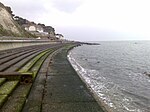1962 Channel Airways Dakota accident
1962 disasters in the United Kingdom1962 in EnglandAccidents and incidents involving the Douglas C-47 SkytrainAirliner accidents and incidents involving controlled flight into terrainAviation accidents and incidents in 1962 ... and 3 more
Aviation accidents and incidents in EnglandEngvarB from July 2014May 1962 events in the United Kingdom

The 1962 Channel Airways Dakota accident occurred on 6 May 1962 when a Channel Airways Douglas C-47A Dakota, registered G-AGZB and operating a scheduled passenger flight from Jersey to Portsmouth, collided with a cloud-covered hill at St Boniface Down, near Ventnor on the Isle of Wight. The aircraft had previously been owned by British European Airways, and was named "Robert Smith-Barry". The aircraft was destroyed, and twelve of the eighteen occupants were killed (all three crew members and nine out of 15 passengers, including three infants).
Excerpt from the Wikipedia article 1962 Channel Airways Dakota accident (License: CC BY-SA 3.0, Authors, Images).1962 Channel Airways Dakota accident
Lowtherville Road,
Geographical coordinates (GPS) Address Website Nearby Places Show on map
Geographical coordinates (GPS)
| Latitude | Longitude |
|---|---|
| N 50.6027 ° | E -1.1977 ° |
Address
Ventnor Downs
Lowtherville Road
PO38 1BL , Lowtherville
England, United Kingdom
Open on Google Maps









